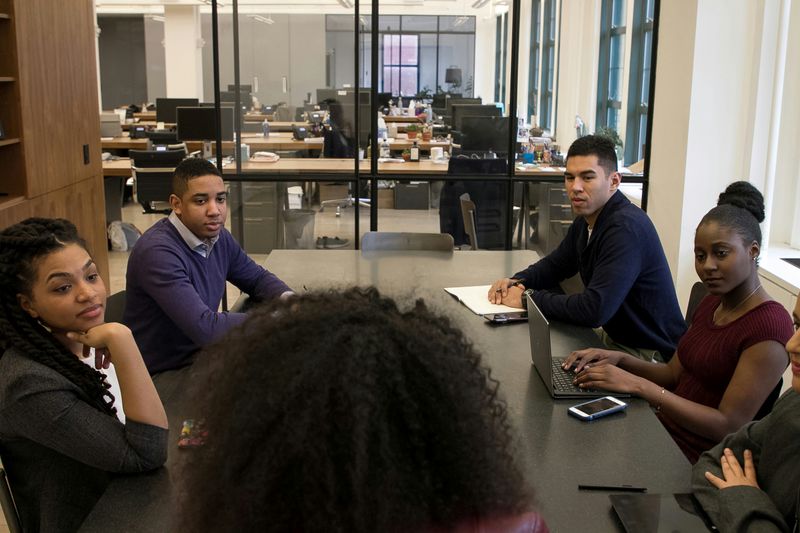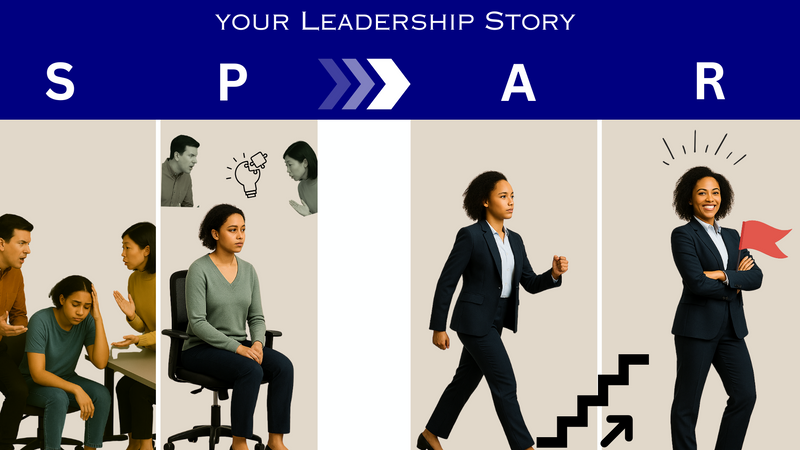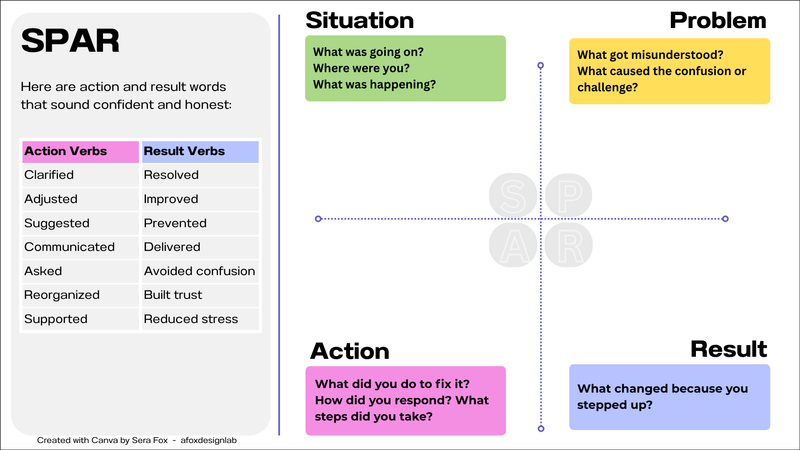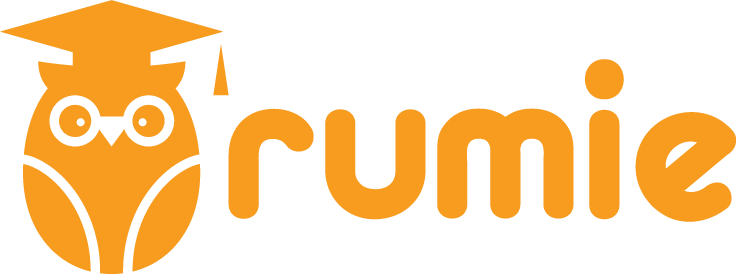 Photo by Christina @ wocintechchat.com on Unsplash
Photo by Christina @ wocintechchat.com on UnsplashIn an interview, you might hear: “Tell me about a time you resolved a misunderstanding.”
They’re not looking for something impressive. They want to hear how you handled a real situation — even a small one — that shows how you:
Clearly explain the situation
Take meaningful action to solve the problem
Show what happened as a result.
That’s what tells them you’re ready to lead, not just when things go right, but when they don’t.
Learn how to tell your story with authenticity and real impact using a powerful approach called SPAR (Situation, Problem, Action, Result). This method helps you break down your experience, focus on what matters, and highlight the difference you made.
You’ll be ready to share your experiences like a leader, with stories that prove who you are when the pressure is on.
 Quick Reflection: Think About Your Own Misunderstanding Story
Quick Reflection: Think About Your Own Misunderstanding Story
Take a minute to think about these questions:
Have you ever had a misunderstanding with a friend, teacher, teammate, or family member?
What happened?
Did you step in to fix it?
If you could redo it, what would you do differently?
Why Interviewers Ask About Misunderstandings
 Photo by The Jopwell Collection on Unsplash
Photo by The Jopwell Collection on UnsplashMisunderstandings are a natural part of life. Even with the best intentions, things can go sideways. Someone might misread a message, make a wrong assumption, or miss an important task.
But strong leaders don’t ignore these moments. Theystep in, clarify what went wrong, and help the team move forward.
When a misunderstanding is left unresolved, trust can break down. If it’s met with defensiveness, collaboration suffers. But when it’s handled with clarity and calm, it builds connection and shows real leadership in action.
Leadership is built in these small moments. That’s why your story needs to be clear, focused, and real. And that’s why we use SPAR, a simple method to tell your story like a leader.
Let’s break it down.
How to Use the SPAR Method to Answer Interview Questions
SPAR stands for:
Situation — What was going on? Set the scene. Where were you? What was happening?
Problem — What got misunderstood? What caused the confusion or challenge?
Action — What did you do to fix it? How did you respond? What steps did you take?
Result — What changed because you stepped up? Did things get back on track? Was trust rebuilt? What got better?
The situation and problem set the stage. They explain what was happening and why it mattered. But action and result are what show who you really are.
Example
Let’s look at how SPAR works in a short, real-world example.
 Photo by Brooke Cagle on Unsplash
Photo by Brooke Cagle on UnsplashSituation: I lead a group project at school.
Problem: A teammate thought someone else was doing their part, so work was missing.
Action: I organized a team check-in to clarify roles and realigned tasks.
Result: We finished the project successfully and improved how we assigned responsibilities
A teammate dropped the ball — yeah, that’s the setup, but pulling everyone into a quick check‑in and still hitting the deadline is what really shows who you are. That’s where the real story starts. 👈
How to Show Leadership in Interviews: Focus on Action and Result

When you're asked to describe a misunderstanding in an interview, it can be tempting to focus on the setup. You might explain what happened, who was involved, and where things went wrong. These details are important. They create the situation and define the problem.
But the situation and problem are only the starting point. What matters most is what you did next, and what changed because of it.
The action shows how you responded. It reveals your ability to stay calm, take initiative, and guide the team through a challenge.
The result shows the outcome of your choices. It proves that you did not just react. You resolved the issue and made a positive impact.
Many people can describe a problem. Leaders go further. True leadership shows in results, the lasting impact your actions create. It’s the proof that you didn’t just react. You made a difference.
This is how you turn a situation into a success story. It’s the difference between saying “There was a problem” and saying “I solved it, and here is what changed.” That’s why the action and result matter most. They show that you weren't just a bystander, but a leader.
How to Write Strong Action and Result Statements for Interviews

In an interview, your story is only as strong as how clearly you explain what you did and what changed. Clear action and result statements offer a glimpse into your leadership style and the values behind your decisions.
The tips below will help you make these parts of your story stand out:
Be clear and direct: Use strong verbs and specific language.
Avoid vague phrases like "We figured it out," or "Things got better." 🗸Instead, say “I set clear deadlines for the team.” ⬅️
Own your role: Focus on your actions, not just the group’s.
“I organized the project and kept everyone on track.” ⬅️
Connect action to impact: Link what you did to what changed because of it. 🗸
“I clarified roles, and we finished on time.” ⬅️
Keep it simple: Skip the buzzwords. Be specific and straightforward. 🗸
“I created a checklist to keep us on track.” ⬅️
Say what you did, what changed, and own it. Make it clear. Make it count. If a friend wouldn’t get it, neither will your interviewer. 👈
How to Sound Confident (Not Rehearsed) When Telling Your Interview Story
SPAR is a great framework for shaping your story, but remember: it’s just a guide, not a script. If you rely on it too heavily, your answer may sound rehearsed or overly formal.
Use SPAR to stay clear and focused, but be sure to speak in your own voice. The most effective stories are the ones that reflect your personality, your values, and your real experiences. After all, no one can tell your story better than you.
Now, let’s look at a few common pitfalls and how to avoid sounding like a robot in a blazer.
 Want to hear this info instead? Hit the play button below to listen.
Want to hear this info instead? Hit the play button below to listen.
Sound file created using TTS Maker by Sera Fox
Quiz: Which Interview Answer Best Follows the SPAR Method?
 Photo by Paolo Nicolello on Unsplash
Photo by Paolo Nicolello on UnsplashScenario: In an interview, you were asked to describe a time when you handled a misunderstanding. You recall a situation from your part-time job at a café. During a busy morning rush, a coworker misunderstood a drink order for a regular customer who already seemed stressed. You decided to step in.
Which of these responses best uses the SPAR method and clearly shows what you did (Action) and why it mattered (Result)?
A. “I quickly remade the drink and apologized, so the customer left happy.”
B. “I stepped in to help, and the problem was solved.”
C. “I clarified the order, remade the drink, and checked in to make sure the customer left satisfied.”
D. “I noticed the mistake and hoped it would work itself out.”
Quiz
Which of these responses best shows the SPAR method and clearly shows Action and Result?
Take Action

Remember the misunderstanding you thought about at the start of this lesson? Now it's time to turn that moment into a strong story using the SPAR method.
You can organize your story in four parts: Situation, Problem, Action, and Result. Here are some helpful verbs to describe what you did and what changed, using a tone that is confident and honest:
Action verbs: clarified, adjusted, suggested, communicated, asked, reorganized, supported
Result verbs: resolved, improved, prevented, delivered, avoided confusion, built trust, reduced stress
Jot it down in 4 to 6 sentences. (Estimated time: 2–3 minutes)
Your feedback matters to us.
This Byte helped me better understand the topic.
